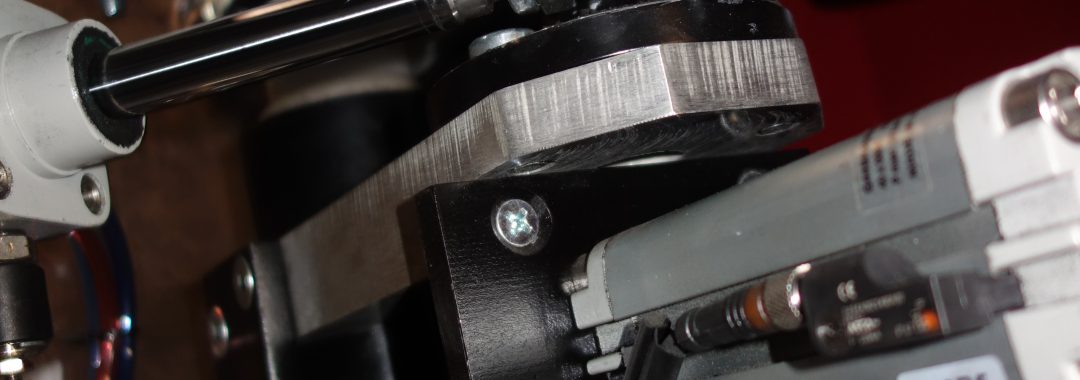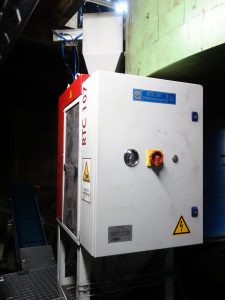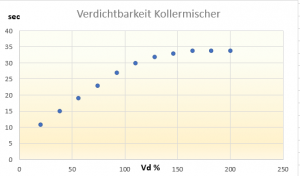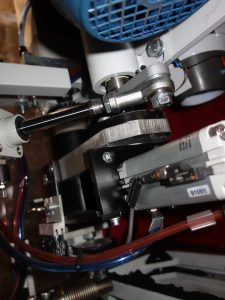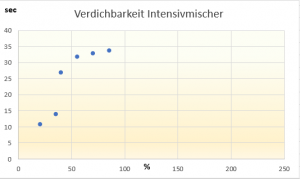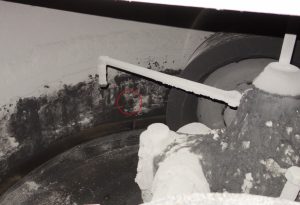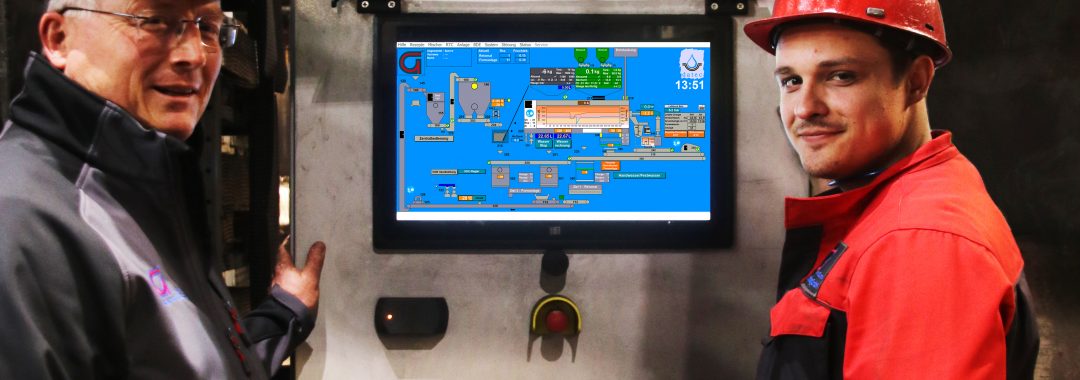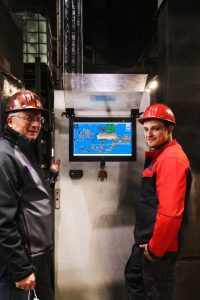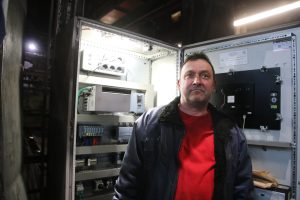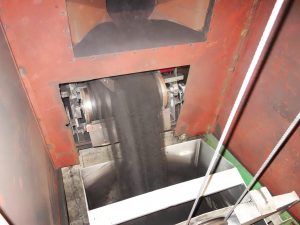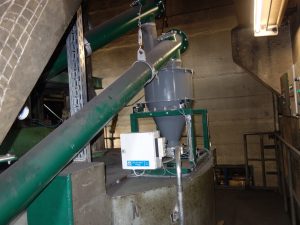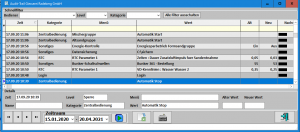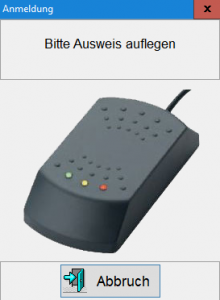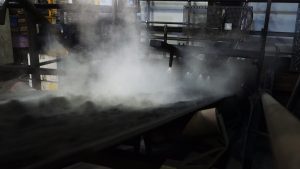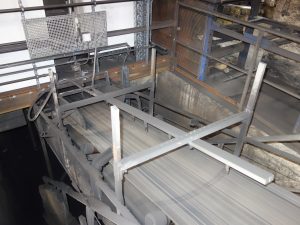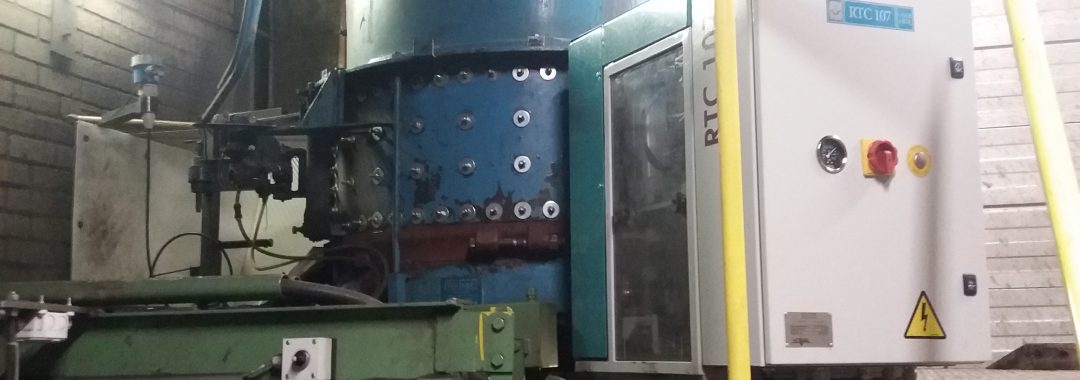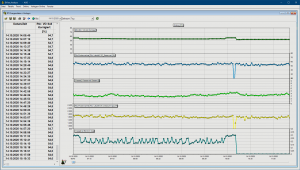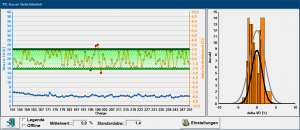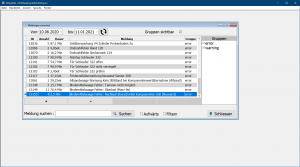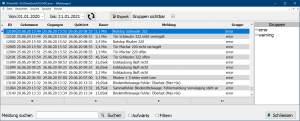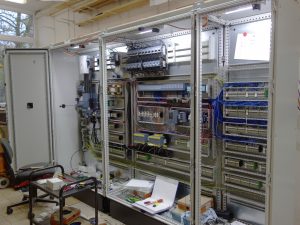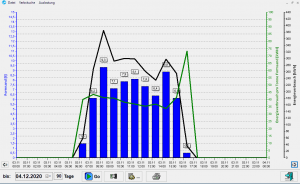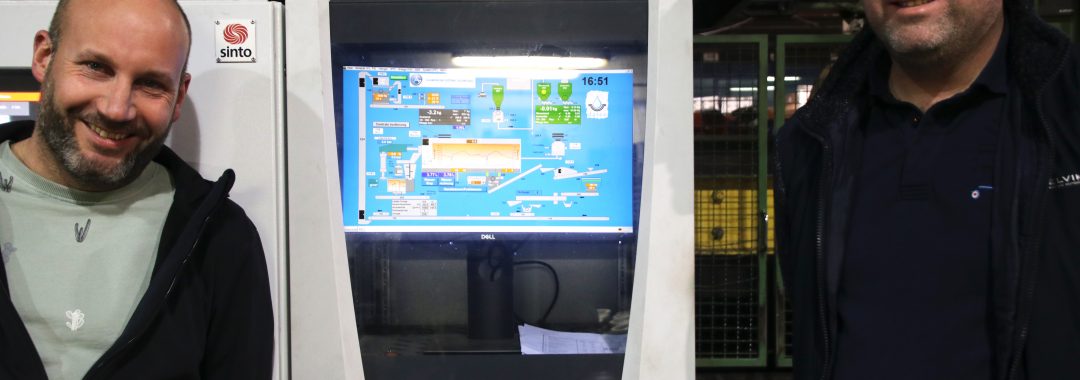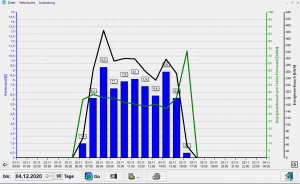News
News about datec
What’s new
Even the compaction behaviour of an old pan grinder can be controlled More transparency in the mixing process
by Wolfgang Ernst (company datec GmbH), May 2021
A classic pan grinder with its heavy and large iron wheels requires up to four or even five times the mixing time of an intensive mixer - i.e. about six to eight minutes - for proper preparation. The temporal behaviour of the development of the compaction values was of interest here as a control behaviour adjustment parameter. With the aid of a tool that draws one sample after the other every 20 seconds for the entire mixing cycle, it can be seen that a pan mixer needs up to 3 minutes after the addition of water to achieve 35 % compaction, while an intensive mixer reaches the final value in about 30 seconds. The two diagrams show the different behaviour. "We were surprised, but the GISAG mixer does its job and produces good sand. In addition, we now see much more precisely how the mixer works and how the moulding material reacts and develops during mixing. We have more transparency in the mixing process." Hendrik Schuster, Head of Quality Assurance (B)
Energy efficiency control
The energy efficiency control programme plays a special role by switching off sand preparation in part or in its entirety and automatically starting it up when sand is needed again. Analogue laser level sensors accurately detect the fill level. Switch-off thresholds, which can be changed via the menu, allow for precise switching off and triggering of the sand supply. "We have simply taken a step forward in terms of ISO 50001. We now record the specific energy consumption in sand preparation and have a core parameter for evaluation, kWh per tonne of moulding sand. We can see pretty much exactly where we stand," Dirk Reinke points out, referring specifically to this control module. "With this retrofit measure, which only affects the control system, we have significantly modernised our sand processing plant and it has no need to fear comparison."
You will find more information about our retrofit here.
You will find more information about our sand testing system RTC 107 here.
You will find more information about our Shake-out_Cooling here.
You will find more information about our energy efficiency control here.
You will find more information about the company Gießerei Radeberg GmbH here.
Gießerei Radeberg GmbH decides to rejuvenate its sand preparation by means of a retrofit – datec delivers an immediately functioning plant in only 7 weeks
by Wolfgang Ernst (company datec GmbH), May 2021
"We knew right from the start that it would be a challenge to install a new control system, new weighing technology and then our RTC automatic moulding sand tester on a pan grinder in such a short space of time." Said datec’s Managing Director Christian Ebert, speaking retrospectively about the swift retrofit project.
"We serve small series niches and we want to deliver quickly with good quality every time. It should not matter whether we need good sand first thing on Monday morning or Wednesday lunchtime or not until the end of the shift on Friday night", explains Managing Director Dirk Reinke on the aim of the investment project at Gießerei Radeberg GmbH. The measurement and control technology in the entire sand processing plant had become a weak point.
Gießerei Radeberg GmbH, which emerged from a centuries-old tradition of glass mould casting, is one of the few companies that still cast glass moulds, but that is no longer nearly enough. In the meantime, small batches are produced on two moulding lines. A hand moulding shop is also available for piece weights up to max. 1000 kg. In both areas, complex and core-intensive parts are the main focus. Due to relatively small melting furnaces, the company is able to produce more than 30 different casting qualities. A wide range of approvals for the marine industry and also the possibility of supplying completely machined parts round off the manufacturing possibilities.
It began with the replacement of the old contactor control circuit, still from GDR times, which was replaced by a modern PLC control system of the latest generation. To meet the requirements of unmanned operation, a central visualisation system was set up on the moulding line for monitoring "from a vantage point". From there, the system is operated; tasks such as changing the recipe selection or recording and acknowledging faults that occur. The multitude of measured values from the new measuring devices is displayed on the screen and later continuously documented in the batch report.
"That was a feat of strength because we had to take on the task of dealing with the main supply cables right at the beginning." adds Steffen Müller, Head of Maintenance. "We wanted to comprehensively improve operational safety and make sure there were no more crazy malfunctions. We managed to implement and achieve that in the space of a fortnight."
With the aim of improving the uniformity of the moulding sand values, the sand preparation plant was equipped with new measuring technology. For example, the inlet of the bucket lift for the used sand dosing system was fitted with cutaway platform scales.
The big step forward was taken with the installation of the ROTOCONTROL RTC 107 automatic moulding material tester for continuous measurement of compaction and compressive strength. The special challenge was the mixer. A pan grinder of the old design with a minimum cycle time of six minutes required a modified control behaviour, as the development of compaction is significantly slower than with an intensive mixer.
"With the RTC, you now have an additional tool. It enables precise coordination of the moulding material and the model. By specifying a compactability in the recipe, you are very flexible and can achieve the target parameters in the shortest possible time," notes Hendrik Schuster, Head of Quality Assurance. "A discussion about the moisture content can be avoided in this way. You receive the data after each batch and are thus informed about the condition of the moulding material at all times. Subjective impressions can thus be matched immediately."
Now no uncontrolled parameter changes can be made by just anyone.
If it goes wrong, no one wants to be the one responsible - the classic worry of many production managers when things suddenly don't run according to plan and it turns out that important parameters have been nonsensically adjusted by unknown persons. As a protection against such unpleasant manipulations, in Radeberg the individual log-in to the operating and visualisation PC is carried out with an RFID chip, which is used by each company employee for personal time recording. Only authorised persons can access the menus and their access and parameter changes are documented. Especially the latter documentation is also useful for carrying out extensive trials in order to evaluate the changes in a targeted and systematic way.
Cooling water dosage behind the unpacking point brings the temperatures down significantly
In the overall package of this retrofit measure, the item - shake_out_cooling for a cooling water dosing system on the conveyor behind the unpacking station was rather insignificant, but the effect has been all the more remarkable. "It even surprised us just how much the used sand is cooled down and also how much moisture remains in the used sand." commented Tobias Herrwerth, a PLC programmer from Braunschweig, on the control system that he had installed. Sands with an unpacking temperature of over 100 °C are easily cooled down to temperatures below 50 °C. "Initially, we were not quite sure whether there would be a sufficient amount of air to carry away the evaporated water. In addition, we were unsure whether the evaporated water would not condense and then drip happily away somewhere."
For water dosing, each unpacking of a box is signalled separately by the unpacking station in order to actually initiate the addition of the water for a short time and at the right moment. An infrared temperature measurement helps to determine the correct amount of water for the desired target temperature range.
You will find more information about our retrofit here.
You will find more information about our sand testing system RTC 107 here.
You will find more information about our Shake-out_Cooling here.
You will find more information about the company Gießerei Radeberg GmbH here.
Click here for the subsequent article.
The implementation of the retrofit measure for sand processing control system in the Dutch Aluminium Gieterij Oldenzaal in Oldenzaal
by Wolfgang Ernst (datec GmbH), January 2021
During discussions on the scope of renewal, all existing electrical equipment was placed under scrutiny. "We wanted to take a big step forward because what used to be sufficient is no longer good enough," Dennis Eekers, CEO at Dutch Aluminium Gieterij Oldenzaal in Oldenzaal, not far from the German border near Rheine, explained the motive for the investment. "No more disruptions and downtime, better sand quality and less waste, as well as much more transparency in the processes, and saving energy."
The beginning for the new control package Sandplant_control by datec GmbH was a new PLC, because the one still in use had long since been discontinued by the manufacturer. A new control cabinet was also envisaged, since contactors that are about 30 years old have a high probability of failure. At the same time, the manual operation system was completely renewed, as the central manual operation previously in use no longer corresponds to the current safety philosophy. Decentralised control boxes with a direct view of the aggregates being worked have significantly increased safety. A special failsafe concept also prevents the automatic control from being switched on centrally if the manual control is switched on decentrally.
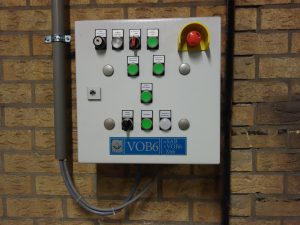
The central manual control was replaced by local control boxes. It can only be operated in sight of the aggregates.
The core of the modernisation and quality improvement is state-of-the-art measuring technology. The two scales were equipped by datec with new electronics for more accurate dosing. Overrun optimization and automatic taring, as well as high resolution in the analog-to-digital value conversion, are the key features for improved dosing technology, especially for a binding material scale that is intended to weigh quantities of around 300 to 400 grams.
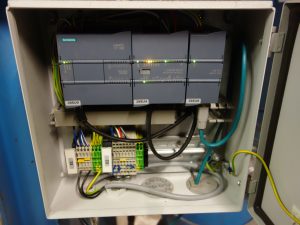
The scale electronics are part of the entire PLC network and are addressed directly via the PLC program.
"We now have a lot more data to help us with analytics and give us the visibility we need." A comprehensive batch report documents the large number of measured values and a special evaluation report helps with the analysis. With the use of statistical process control methods, the process can be analysed in detail and then also evaluated.
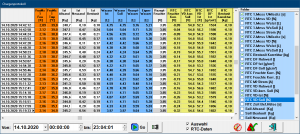
All relevant measured values, intermediate calculations, and menu values are documented in the batch report.
The EVA (Event Analysis) program is used to evaluate all fault messages in the archive. The primary concern here is the duration and number of faults. This information will help maintenance decide which problem to address as a priority.
The continued use of the almost 30-year-old control cabinet was ultimately rejected because the probability of failure over the years was quite high and there were also gaps in the documentation.
"Of course, we pondered whether to go for a smaller or larger solution. We chose confidence - because things are looking up after the crisis and we then want to work through the orders without a handicap."
Energy efficiency
Initially, those responsible did not consider an energy efficiency control system, which automatically shuts down the sand preparation system when idling, to be necessary. But after a reference visit, the opinion changed, because then it was also seen at home how even with a foreseeable longer idle time, the system was not stopped manually. The system used to continue running through the break. Now the system switches off automatically and energy is saved. Energy consumption is recorded via a meter and later processed for sand production in an index calculation - kWh / 1 t moulding sand.
You will find more information about our retrofit here.
You will find more information about the company Aluminium Gieterij Oldenzaal here.
Dutch aluminum foundry Gieterij Oldenzaal invests in sand processing
by Wolfgang Ernst (datec GmbH), January 2021
30% higher sand throughput after retrofit of controls
A comprehensive renewal of the PLC control, the power unit and also the measurement technology resulted in significant improvements in the sand processing of the Dutch Aluminum Gieterij Oldenzaal in Oldenzaal, near the German border.
“Our controls were getting on in years and individual devices were no longer working properly. We had to act. ”Danny Vreriks, Process Engineer and Planner, explained the investment measure. “A repair was no longer worthwhile - we had switched off the moisture measurement / water metering and added the amount of water manually using a fixed value. The weighing of the used sand was too imprecise and we always had too much sand in the mixer and had to significantly reduce the batch weight. "
After it became clear that the innovation reserves for sand preparation were in the control and measurement technology package Sandplant_control, the company decided on a large and comprehensive solution with us, the company datec.
Managing director Dennis Eekers wanted to implement 4 goals:
• Safe, state-of-the-art control
• Significant improvement of the sand quality through even sand values
• Reduction of electrical energy consumption
• Traceability and evaluation of the sand values through long-term storage of the batch values with the help of SPC programs
The exchange of the control could of course not be accomplished like a tire change, because it was a clear improvement and the latest technology should be used. Not only was the latest PLC and a completely new power unit installed, but the weighing technology and moisture-dependent water metering with our datec system akwa_mix were also renewed. An important step towards improving quality was the installation of the ROTOCONTROL RTC 107 on the mixer for online molding material testing in the mixing cycle with direct correction of compressibility and compressive strength.
With DView, the operation and display was relocated from the old control room to the molding system. The most important operating states and measured values are displayed online with a sufficiently large screen visualization. The molding machine operator can change the recipe himself very quickly when changing models. Faults in sand processing are displayed immediately and can be remedied from there.
Even with an older mixer, the investment is worthwhile
Hardly any modifications were made to the system itself during the investment; the new electrical equipment alone enabled significant improvements to be achieved. The original batch weight of 200 kg could be increased to 260 kg and at the same time the uniformity of the sand could be increased. The compressibility fluctuates only slightly, namely 1.5% in the 1st standard deviation.
In the spirit of the general energy-saving discussion, sand processing was also implemented with the Energy_control program module. An operating mode that automatically stops the sand processing when idling is detected and starts up again when sand is required. Although there are no long-term secured data with reliable findings, a conservative estimate is based on savings of at least 10%.
Click here for the subsequent article.
